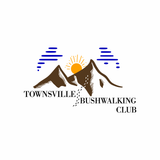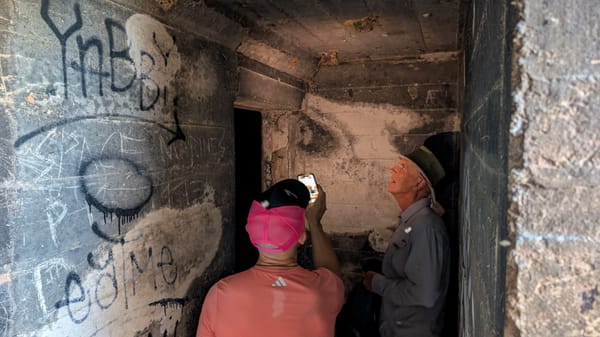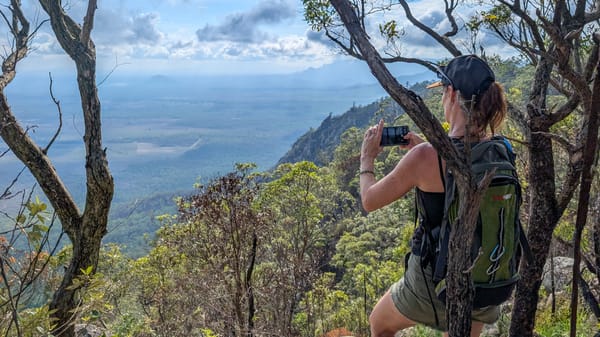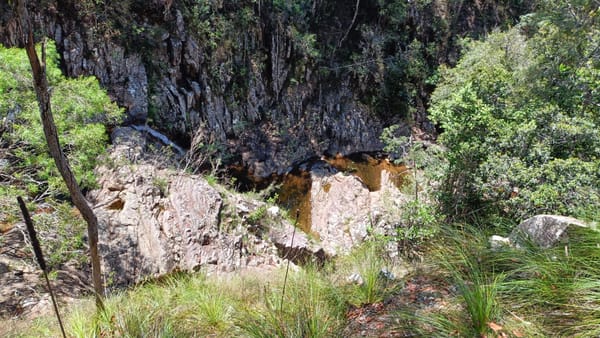Escape Magazine – August 1987
This 1987 Escape edition features treks from Boggy Camp Creek to Thornton Peak, Dave Whyte’s Yamine Falls saga, and a chilly Mt Elliott camp. Plus, Marg Hayes on trekking Nepal, bush skills for stings and bites, and even a bushdance notice—capturing adventure and community in equal measure.
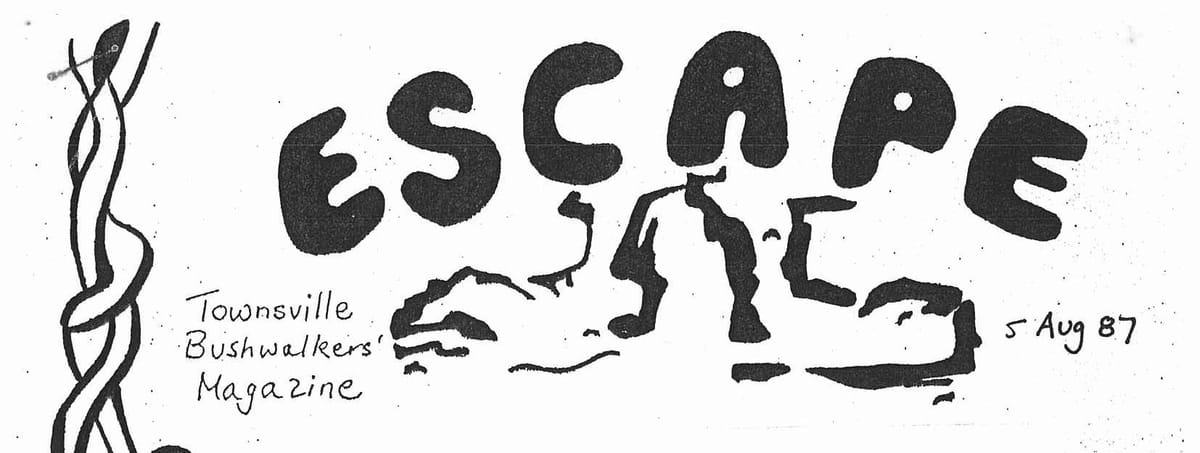
ESCAPE
Townsville Bushwalkers' Magazine
5 Aug 87
Hello Bushwalkers,
This edition of the magazine promises some interesting reading. Marg has given us further insight into her world-tour with an article on Nepal. As well, there is a report on an assault of Thornton Peak and a write-up of the Yamine Falls trip. All this and MORE! Thanks heaps to those who have contributed.
And ... for those of you itching to put pen to paper, all contributions to the magazine (ie trip write-ups, jokes, classified ads, and any other useful, useless or interesting information) are happily and graciously accepted. The deadline for the next edition is 16 September.
Mary Jane
From your Social Director . . .
Remember we meet on each Friday before a day-walk (ie 7 August) at 6:30 pm or so at the Metropole Hotel in South Townsville for a meal and/or drinks. Just make your way to the beer garden and you'll find us there.
We also plan a monthly BYO BBQ. The venue changes as different people offer to host the event. The next BBQ will be organized at the 5 August meeting so keep your ears perked for details.
Thank you to Peter Morgan for hosting last month's BBQ. Everyone enjoyed themselves.
And thank yous are due to another Peter -- Peter Liston and Wendy Henderson generously allow us to invade their premises when we are unable to use our usual venue. Many thanks.
MARION
BOGGY CAMP CREEK
Anyone looking through the club log book will have noticed descriptions of three attempts to find elusive aboriginal cave paintings in the hills at the back of Kennedy. On the third attempt in April 1962 these caves were finally located. The condition of the paintings was described as ranging from quite distinct to barely visible.
The idea of finding these caves again had caught my imagination & eventually, in the company of a friend, I found myself wading up what we had decided was probably Boggy Camp Creek. This lies between Kennedy & Meunga Creeks just north of Cardwell.
About half an hour from the car, what had been a sandy creek bed abruptly changed into that more familiar surface of wet slippery rocks with large granite boulders eventually becoming apparent along the banks of the creek. We expected the caves would probably turn out to be rock shelters & now realized that they might be found under the larger of some of these boulders.
It was around midday when thoughts of food were interrupted by the discovery of the approaches to an old bridge. Up until now, our position in relation to the maps sketched in the log book was pure guesswork & we had been detouring from the creek to inspect anything that held hope of being a rock shelter. However the log showed the remains of two old bridges & the approaches to this one were very similar to one of those. If this was the same bridge then we wern't to far from the caves. it seemed to easy.
A quick lunch & with a sense of optimism we were off up the old timber track associated with this bridge (probably the beginning of Sullivans track shown on some maps), searching for the 'Art Gallery' as Ray Lane had called it in the log. The rain appeared to be clearing & the mozzies, which until then had been unpleasantly attentive, seemed to be loosing interrest when a large rock shelter appeared just of to the right of the track. There were no obvious signs of rock paintings however & as the distance travelled from the bridge was about half that suggested in log we continued on. A few kilometers further on the track became difficult to follow & as there was no longer any sign of the large boulders, it was back to that first shelter.
From here, following compass bearings shown in the log, we located two other caves proving fairly conclusively that the former was the one referred to as the 'Art Gallery'. So where were the paintings described as quite distinct? Closer inspection revealed vague outlines of what may have been what we were searching for, however these were blackish in colour as if they had been affected by mould or perhaps the smoke from fires.
The descriptions in the log were written twenty five years ago, however one would imagine that anything deteriorating at a rate transforming it from being quite distinct to barely discernable in that space of time must be of quite recent origin. When did the last aboriginals live in this area?
Perhaps the rate of deterioration has increased for some reason. The passage of the timber track right past the site would have exposed the shelter, at least temporarily, to an increase in reflected sun light, possibly affecting their survival to some extent. It would also have made them more accessible to thorough people, how much damage would hands touching the paintings or camp fires lit in the shelter of this rock cause?
A little disappointed we spent that night by the remains of the old bridge & part of the next morning was spent poking around up the creek. To return to the car, a faint walking track that crossed the creek near our campsite was followed. Five minutes along this & we found ourselves on a modern forestry track which, in half an hour led us back to the vicinity of the vehicle.
As a potential walk Boggy Camp creek is not terribly inspiring. The section above the bridge is quite interesting with a waterfall & pools large enough to soak the body in, but not really large enough for swimming nor deep enough for Steve & Daves usual activities. It soon divides into two smaller creeks neither of which promise anything of great interrest. Overlooking this junction is another of the caves mentioned, this also contained no impressive displays of cave paintings, however with its rough stretcher, pots & pans, shovel & other items concealed in a corner it is obviously the part time residence of someone who, on this occasion, was not at home. If the 'Art Gallery' was a bit less dissapointing the area may have justified a one day walk, as it is, I don't think anyone would be very excited by Boggy Camp Creek.
CHARLIE
Most of us should have a reasonable idea of the correct treatment for snake bite but what about all those other stinging & biting critters. The following chart should answer most questions.
| Pressure/Immobilisation | Do not apply Pressure/Immobilisation | Application of *Vinegar | Application of Cold Pack | Application of *Hot Water | Antivenom Available |
|---|---|---|---|---|---|
| Snakes land and sea | Red Back Spider | Box Jellyfish and other Jellyfish stings | Red Back Spider | Stonefish | Snakes land and sea |
| Box Jellyfish (AFTER VINEGAR) *Blue Ringed Octopus |
Stonefish | Scorpions | Bullrout | Funnel Web Spider | |
| Cone Shell | Bullrout | Centipedes | Sting Ray | Red Back Spider | |
| Funnel Web Spider | Ticks | Bees, wasps, ants | Fish barbs | Box Jellyfish | |
| Bees, wasps, ants (if allergic) | Ticks | ||||
| Sting Ray (if casualty becomes ill) | STONEFISH | ||||
| Fish barbs (if casualty becomes ill) |
- *Note on 'Pressure/Immobilisation': Usually a painless bite
- Note on 'Do not apply Pressure/Immobilisation': N.B. The restriction of the venom movement will result in tissue damage and will increase pain.
- *Note on 'Application of Vinegar': *Any type of vinegar contains the correct percentage of acetic acid
- *Note on 'Application of Hot Water': *CAUTION - do not scald the spiked area. Temperature of water should be approximately 50°C. (Test with uninjured limb)
Remember - death is preventable if the rescuer can give:
- BASIC LIFE SUPPORT (assist the unconscious, apply EAR and CPR when necessary)
- and APPLY PRESSURE/IMMOBILISATION (where necessary)
- and SEEK URGENT MEDICAL AID
TREKKING IN NEPAL
I had always wanted to go trekking in the Himalaya as it sounded wonderful. I have been twice now and it is absolutely fantastic. You have to go yourself to really appreciate the magnificence of it. Snow-covered peaks shoot up from the terraced lands of subsistance farmers. Every which way you look there are mountains, huge ridges of them, their height beyond comprehension. They seem to be just above you but it may be another 4,000 metres before you reach the summit. I used to stare in awe at them and really respect the mountaineers who climb them. The glaciers are something else -- walking on them is quite unnerving as you are very aware of the constant danger. Glaciers move (however slightly) and there are hidden crevasses. It is like a moonscape of ice. Mind you, you do not have to walk on the glaciers. You can view the magnificent mountains from afar without having to worry about altitude sickness (this happens at above 3,000 metres) let alone glaciers or avalanches.
Nepal, up to about 3,000 metres is heavily populated, so if you are thinking of wilderness -- forget it. As you walk you pass through villages (about one village every two hours or so) where you will find bhattis or tea-houses where the independent traveller can sleep and eat. The bed is usually a mattress on the floor or a basic bunk -- communal style. There is always dhal bhatt (lentil soup and rice), potatoes, and milky tea. In some places there are such exotic foods as yak steaks, fresh apple pies, and bottles of coke. It is really unnecessary to carry a tent or your own food unless you are going into a remote or very high area or are a msochist!
The tracks are well-worn as they form the highways of Nepal. They are extremely steep and you need to be fairly fit. The fitter you are, the more you will enjoy the trekking. As well as seeing incredible scenery, you will see incredible people, some lugging massive loads of goods in baskets. Even young children carry heavy loads. The people work very hard with very few machines. They live very simply in mud or slate houses, cooking over an open fire. Yet, they are extremely friendly and happy people who do not try to rip you off. We are very rich compared to them.
The first time I went to Nepal I went on an organized trek. This is where you walk carrying only your daypack. Everything else, from setting up tents, to cooking meals, to carrying your gear is done for you. It is quite luxurious. The second time I trekked alone and stayed with locals which I really enjoyed. I met quite a few other trekkers though I was often the only trekker staying in a vilage. My only unpleasant experience involved other "foreigners".
On both trips I went up to over 5,000 metres and did not get very sick on either occassion. I trekked the first time to Everest Base Camp and the second time around the Annapurnas and up to Annapurra Base Camp. Both trips are full of absolutely magnificent scenery and wonderful people. Don't forget your camera. It is worth taking a good one, Nepal is a real culture shock but it is definately a worthwhile experience -- I'll be going back again. Make sure you go with an open mind. You'll love it!
MARG HAYES
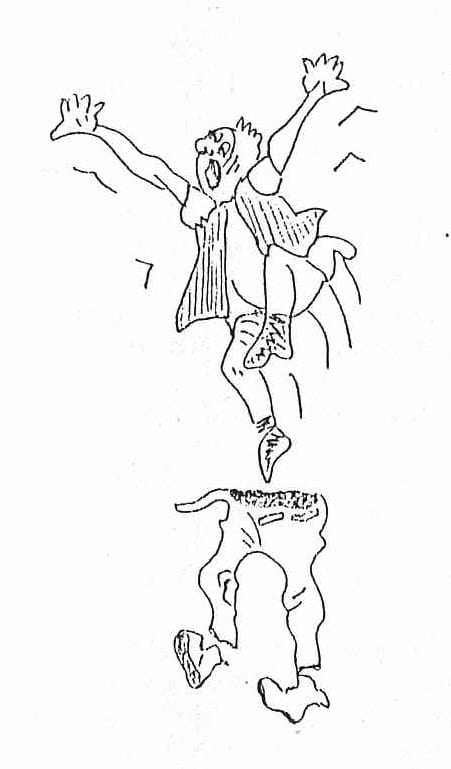
! DANCE YOUR PANTS OFF !
BUSHDANCE
ROCK WALLABY
8pm
Sat 15 Aug
PYC Wellington St
Adults $5
Children 7-12 yr $2
Under 7 Free
CLASSIFIED ADS ... CLASSIFIED ADS ... CLASSIFIED ADS ... CLASSIFIED ADS ... CLASSI
...CLASSIFIED ADS ... CLASSIFIED ADS ... CLASSIFIED ADS ... CLASSIFIED ADS ...
HOUSEMATE WANTED
WANTED: One (or two) single, non-smoking, vegetarian, conservation-minded male to share fully-furnished house. Queen-sized waterbed provided. Lawnmower and stereo owner prefered. Applicants should play musical instrument but not spend too much time at home. Must enjoy housework (and have a sense of humour). $50.pw for one/ $33.pw each for two. Eligible applicants to contact Glynis.
THANK YOU
Thank you to Ted and Anne for their hospitality on the week-end of the Paluma Rainforest Festival. What a terrific tent-site!
ARTIST
WANTED: Artist (of any calibre) for this magazine. Please help!
IN MEMORY
LEST WE FORGET ... 19/20 July marked the 1st anniversary of the infamous Cape Cleveland trip...
THORNTON PEAK
JULY 1987
Thornton Peak has the reputation of being inhospitable. This venture examines the truth behind this myth.
Having gained the necessary permits from a not-too-co-operative National Parks official in Cairns, and having been subjected to the mandatory, and very helpful interview by a National Parks botanist, we felt that we knew the peak intimately. We were warned of the predictable poor weather, rats, snakes, and a particularly delicate flora. None of this we actually saw, so pehaps the in-depth interview was just as well.
We (Roy Flynn, Mary Jane, and myself) considered ourselves suitably prepared for our three-day venture. With compasses and two maps, one a photocopy of the track as described by our friendly botanist, and the other a free-hand drawing of the track. The compasses were next to useless in the terrain we encountered.
The night before the adventure we camped at Thornton Beach. This was a bad move as it took us some two hours to retrace our steps to the start of the western access to the peak. Port Douglas would have been more convenient.
So, two hours were already lost and the next 3 to 4 were wasted trying to find the start of the track that we belived was taped. No luck. Having lightened our loads by having lunch before the initial climb we decided to ascend a likely creek and God willing, stumble across the track at the top.
This was accomplished with remarkable ease. And, as it turned out later, we had in fact picked the correct creek for the ascent. This climb covered approximately 1 Km and we ascended some 160 m.
This whole area has been heavily logged so there is lots, and I mean lots, of wait-a-bit. At 160 m we came up against a wall of the stuff. Knowing that the track was within 50 m or so of us, we pressed on.
The track ends in a creek. Across it is about 2.5 Km of paper bark, ti-tree, and fern swamp. We cleared the fern by sundown and camped on a creek. I must add that where the track ran out, the tape began.
The next day dawned and we were about 1 Km short of our proposed first campsite, so we packed up and moved on. We traversed relatively flat ti-tree swamp, found the campsite, and set-up in the rain.
Decision time . . . do we have enough time to make it to the top and back that day? There was no point in camping up there as it was obviously going to be too wet. We decided to go.
We packed a lunch and a bit extra, raincoats, a space blanket, and a ground sheet, crossed two creeks within 500 m of the camp, then up - and up - and up.
Leeches, rain, mud, and ever up. We passed a tree blazed 3000. It must have meant feet so we were at about 1000 m. Up and Up. We decided to stop for lunch . . if we could find some level ground . . cold and wet but we needed the stop.
It was about 2:30 - not enough time or light to get up there and back. I estimate we were within 300-400 m of the top. Thoughts of a warm, dry camp turned our heads for home. The distance from base to this point - approximately 380m up.
All this time it had been raining. So it was slip, slide, bump, slither all the way down, only stopping to pick ourselves up and pick leeches off.
Nearing the bottom we became increasingly anxious of the noise coming from the direction of our camp. We didn't realize just how much it had been raining. There was no way back over those two creeks that night.
It was then about 5 pm and we set to make the best of what we had. Roy managed to get a fire going and I will be eternally grateful to him for that. We used the ground sheet as a fly; hats and the dismantled pack became "cushions" on the running, soggy ground. Our clothes were wet but we had some extra food.
We spent 13 hours cramped together around the smokey fire with the space blanket around the three of us. Lots of brews passed the time. One female got so water-logged that she refused the brews for fear of having to venture the two inches into the roaring, dripping storm.
By dawn the creek had fallen sufficiently to cross safely. It took us five minutes to get back to the dry, unused camp. We had breakfast and packed up.
The return trip to the car was uneventful. The sun came out but it wasn't enough to dry the inch of water standing over ground that had previously been dry. We found trees that had been downed during the night and lots of evidence that all the creeks had been up.
The area north of the ferns is an old orchard. Here the taped track meanders amongst old citrus trees, a fact we hadn't time to notice on the way up.
Following the logging trail put us right back into the creek we had chosen to climb up. We didn't notice the cutting on the way up and didn't realize we were in the same place and at one stage opted to try and go cross-country through mountains of wait-a-bit to where we supposed the car to be. It is a good thing we were turned back by the wait-a-bit or else we'd have been heading in the wrong direction.
The cars were in sight! We broke out the port we should have had the night before - got quite merry in those last 200 m - a bad move as we had to drive south of Innisfail to get a hot shower.
It was a great trip. I'm looking forward to making it to the top next time.
PETER MORGAN
THE SAGA OF YAMINE FALLS
June Long Weekend
(Dave Whyte's reputation plummetts even further . . . Bea take note.)
At 5:30 am (yes, that early) most of us were ready to leave for the Herbert River when Dave, our illustrious leader, finally arrived and announced we were all there. After an uneventful trip to Abergourie (the writers fell asleep) the twelve walkers made preparations to begin the walk. Our leader showed his brute strength by holding back the horses while we parked the cars. At 8:15 am we began to walk and soon had our first river crossing — knee-deep for our leader as he was seen sprinting across - (Is this a blot in his character? Is he afraid of crocs?)- waist-deep for the rest of us. The rest of the intrepid group (anyone going on a "Dave Whyte Walk" is intrepid) struggled their way across the slippery rocks. Dave was heard to say in the distance, "In N.Z. the rivers are twice as big, deep, and wide. This is a cinch".**
As our leader disappeared into the distance --- his long legs carrying him further in front --- us shorties strained under the weight of 3-day packs to keep up. One and a half hours later we were allowed to stop for morning tea at a lovely sandy spot on the river (we were even allowed to have a fire and a brew).
After yet more marching on the 4WD track (yes, we could have taken a vehicle closer and had a more leisurely trip) we had to do another river crossing --- deeper, longer, more slippery, and with more current --- getting closer to Dave's N.Z. ones! Once again our intrepid leader showed his skills in river-crossing, gallantly helping Glynis across and then rescuing (in dashing fashion) one of Mark's runaway boots ---what a hero!
Along the northern bank we now tramped through cowpads, grass, and lantana. We were making good time (or so Dave thought) and one hour was alloted for lunch. Peter and Wendy tried to attract crocs by splashing around (swimming we think).
Our time-keeping leader roused us from our lunch and one hour (to the second!) later led us further up the river and through croc-infested areas. A lagoon where Ted and Dave had seen a slide in 1985 did not reveal any new slides. We reached the junction of Yamine Creek without a sighting or an attack. "Shucks" said the leader, "I thought twelve was too many and I might get rid of one or two".
Walking along the banks of Yamine Creek was delightful. It's a beautiful creek of fast flowing water (good li-loing rapids) and lovely vegetation. Near the base of the falls we dropped
**N.B. In Canada the rivers are even BIGGER, DEEPER, and WIDER than those in N.Z. People do not attempt to walk across them. Bridges are built for this purpose. Ed.
our packs and armed with cameras, went for a closer look at the falls. Eager for a bit of excitement, Dave proceeded to help Glynis (and camera) see a closer view of the raging creek. Fortunately, Glynis (and her camera) survived with just a soaking despite the attempted drowning.
After this delightful interlude at the falls, Dave led us up, up, up, and yet further up this hill (?mt.). He had said it was "a little steep" but climbing through snake-infested gullies (a 10 ft. long amthestine python --- real cute) was more than most people had anticipated. Fortunately, Dave did "nose out" the gympie bushes for us (yet another sacrifice). One and a half hours later, at 6pm, we arrived at the campsite. Well, it didn't look like one to us but we had no choice.
There was a mad rush as eleven people scoured the site looking for the most comfortable boulders to contort their bodies around. Flies were then erected over these places. Meanwhile, our esteemed leader was seen putting up his hammock. He had forgotten to tell everyone it was a necessity!!
In the darkness an intrepid few jumped into the lovely pool and then set about finding firewood and a place to put the fire. There was much discussion about where to put it as the choice was fairly limited. "Which puddle will we put it in?" When the fire was lit a few people tried fire-walking as a slippery puddle claimed its victims, Dave not being one of them. He had brought his stove!
After dinner Dave decided to try and make ammnends for the hard slog up the hill. As we lay cuddling our boulders we listened to his suave tunes until his flute flooded with the rain.
Sunday dawned and most of the party rolled over and went back to sleep. Ted though, got the fire going (in the rain and puddles). Our leader wasn't seen until it was roaring!
As the day drew on the problem became apparent --- where to go for the loo? Dave was seen to swim across the top of the falls, Glynis packed her backpack and disappeared, not to be seen until lunchtime. Wendy had a panoramic view (we didn't ask where she went!) — so if you could swim raging currents, or scale vertical, wet, mossy, slippery rocks the loo wasn't a problem.
Dave and Peter L. decided to defy the forces of gravity and slippery rocks and went for an exploration upstream. They came back telling us of a beautiful, huge pool in an idyllic setting. They didn't take cameras so we are left wondering — is it real? or just in Dave's imagination?
At lunchtime, after a morning of watching water — fall (yes, the waterfall and the rain) and rock climbing for a bog, we headed back down.
Yes, Dave decided to make this interesting too and organized a race to the bottom — via gullies strewn with loose boulders — Dave won, boulders a close second, the rest of us a quivering mess of nerves — last.
Once down we had a quick break (well some had a longer one!) and then headed on towards the Herbert ever watchful for a lovely campsite. Eventually one was found at the junction of Yamine and the Herbert (well dug by pigs, but soft!)
Tent-city soon popped up --- our illustrious leader still showing his ability to "get" a good site (a two-storied kitchen!)
8:30 am next mornig (the night passed by peaceably) us troops ever eager to tramp onwards stood, sat, yawned, patiently waiting for Dave to set off --- guess who wasn't ready!
Finally we headed downstream --- Dave striding it out as usual. He managed to stop and look at recent croc slides at the lagoon, even volunteered someone else (but not himself) to go "croc-baiting" to draw the local four legged creature. No one volunteered, much to his disappointment!
Onwards we went, but Dave, not being interested in fungi, kept striding as the authors stopped to photograph a rare fungus. After a successful photographic session (fungus being very co-operative models --- they don't move) the two authors strode on, chatting, following the track, ever confident that our faithful leader would be waiting around the next corner, or at least at the lunch spot. (He needs his daily Mars bar you know!)
After some time had lapsed the authors realized that they should have caught up with the rest of the group. Realizing that the group had strayed from the riverbank and possibly got lost, the authors shouted, hey bobbed, and generally tried to outdo the hundreds of birds twittering in the trees but to no avail.
Musing on the fate of their companions they quickly made their way to the first river crossing. Upon arriving there and finding the area uncrossed they proceeded to wait, have smoko, wait, photograph birds, and wait. After quite a while our leader finally turned up with the rest of the group straggling behind. All we can say is, "What a shortcut!"
The remainder of the walk went smoothly with lunch and a swim at Sword Creek.
Yet another "Dave Whyte Walk"!!!
ANNE and MARG
MT ELLIOTT
The air was brisk as we arrived at Mt Elliott National Park camping grounds at about 6.45am on Saturday morning. We set off without much delay in order to keep warm, leaving our jumpers on until we warmed up. It was about one and a half hours before this occurred as we headed up North Creek. North Creek is very picturesque with many ferns and staghorns. We gained altitude quickly as we ascended waterfall after waterfall. At one point, we almost lost Marg as a couple of boulders threatened to force her into a field of gympie.
At 10.30am we stopped for morning tea by another waterfall and 'pool'. Steve was the only one to brave the water which was breathtaking in more ways than one. At this point we had to climb a log to cross at the top of the falls. From here, we could see Cape Bowling Green. Onwards and ever upwards we climbed. Every step I took reminded me of how unfit I was and often I felt like turning back.
We stopped for lunch at 12.30 and had a well-earned rest in the sun. At 1.10pm we set off again and were soon into the rainforest. At 2.30 we left our packs to head up to the lookout on North Peak about 20 minutes away. The view of the coast was supherb and well worth the day's climb. From here, we could also see Mt Elliott. Most of us clamboured up a huge rock by standing on someone's shoulders and being hauled up by Steve. It was times like these that reminded me of some of the words of a song:
"Lean on me, if you're not strong,
I'll help you carry on...
Just call on me brother, if you need a hand,
We all need somebody to lean on."
These words seemed appropriate to many situations during the weekend.
Near the lookout was a campsite that would take about 3 people at a squeeze. Dave's comment was that the campsite was a bit smaller that he remembered. Some people may remember similar comments of the Yaminie Creek Falls campsite. We descended to the creek, passing several rainforest giants. At 3.30pm we gathered water where we'd left our packs and headed up to Mt Elliott about a half hour walk uphill. By this stage I felt I could just sit down and fall asleep. Every step was an effort. The top of Mt Elliott isn't very exciting. There's a massive rock which no-one attempted to climb. Then it was on to the campsite, another 20 mins away.
At last, at 4.45pm, we finally stopped. It was becoming rather cool at 6 C, but Marg soon had a fire going. After we watched Mark labouriously cook up a gourmet meal, Charlie brought out a surprise 2 tonne (not quite) birthday cake which even had the right number of candles on it. (I can't be to old if I can blow out most of them in one breath). So we feasted on cake while Dave serenaded us with his flute playing. During the night the winter woollies emerged. Ched and Marg had the cutest beanies.
The temperature did drop even though Steve's thermometer didn't register below 6 C. Most of us managed to stay up till after 9.00pm.
The next morning, Dave made a super-human effort (it was quite cold) of playing one of my favourite pieces - Grieg's "Morning" from Peer Gynt, and Marg made me a cuppa tea. What a lovely start to my birthday. We left at 9.05am setting off into the eerie mist. There were Alexander palms, orchids not yet flowering and the usual rainforest paraphernalia. Dave mentioned that it was amazing to find such beautiful rainforest so close to Townsville and Marg stated that it was only half an hour's drive away.... "And a 9 hour walk" added Dave.
It didn't take long to find Alligator Creek. It was a steep descent over moss-covered rocks which were lovely and soft to the touch. At 10.30am we polished off the cake that Dave had carried up. Then it was off again. I literally had to run to keep up. One had to ensure one didn't blink or turn one's back or the others would be gone. It seemed that whenever I took my camera out, I would be left alone. Was someone trying to tell me something? I didn't think my photography was that bad.
At one point we stopped to look at an amethstyne python, but it didn't appreciate Steve disrupting its rest all for the sake of a photo. Just after 12.00 we arrived at the top of Alligator Creek Falls for lunch, swim and the other half of the cake. There was a delightful view of Saddle Mt. All of us (except Peter who took off) had a rest. The sun felt so lovely and warm, it was hard to leave. We descended the face of the falls in half an hour. It was quite steep in places and we often found it difficult to stop or slow down. The view was awe-inspiring. Unfortunately, I'd run out of film.
After this it was a 2 hour slog along the track back to the camping grounds where we didn't hang around to see the warden about our non-existent camping permit. We were all a bit worse for wear, covered with scratches and scars - but we had all made it. In fact, it was a well-timed walk as it rained that night. We'd made it just in time.
G. Lee
See the full Escape Magazine Sep 87:
